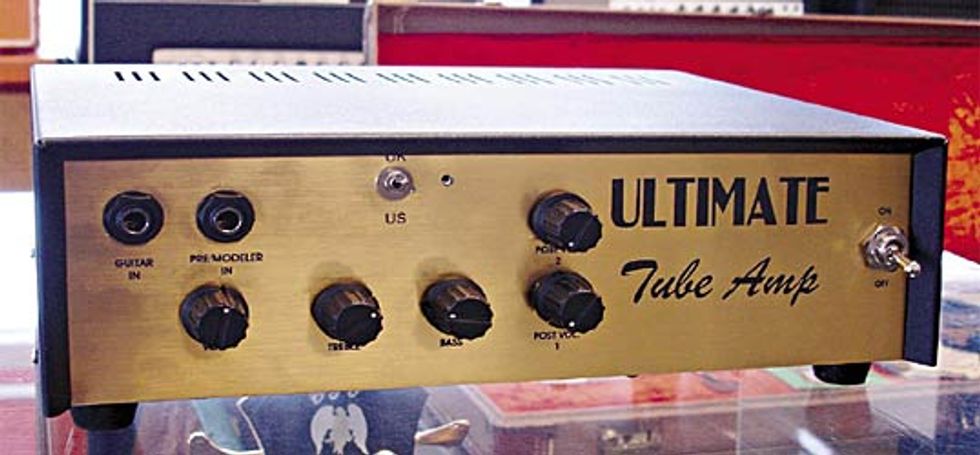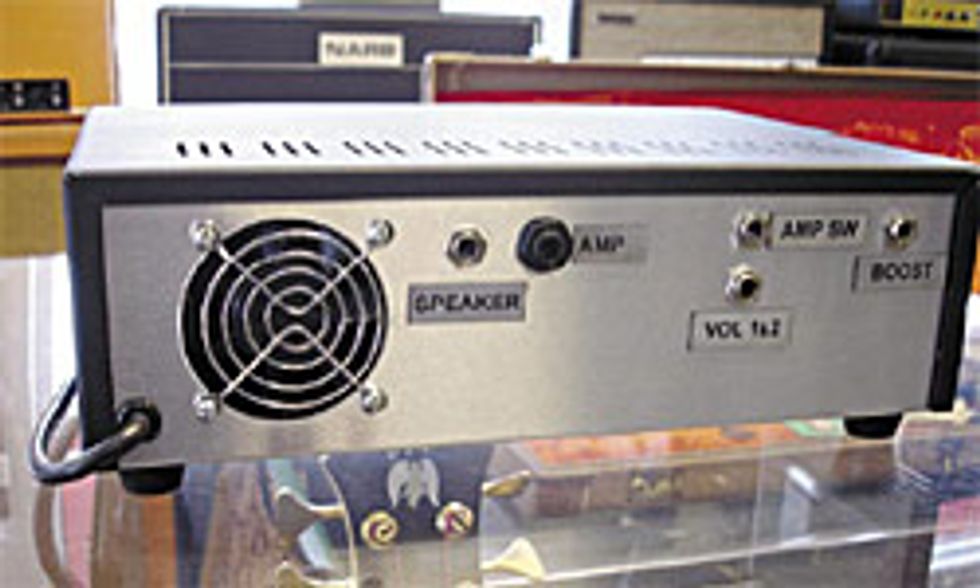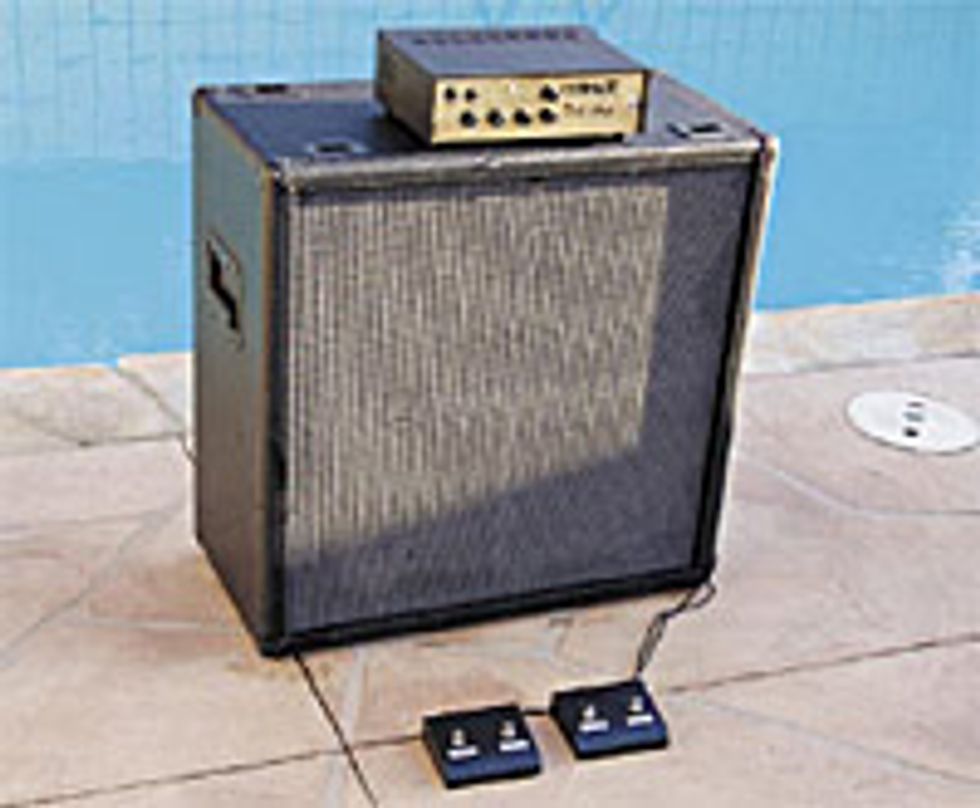
“You have just got to keep that stage volume down!” This is something that we as guitarists hate to hear. Whether it is an angry club owner, vocalists who need to hear their monitors, or any variety of other reasons, these words can sometimes mean the difference between a great gig and a very long night of playing with what you perceive as poor tone with no picking dynamics. We tested the Ultimate Tube Amp, a product that promises to solve that problem entirely.
 The Attenuation Problem
The Attenuation ProblemFor years we have tried different techniques to solve the volume problem, such as turning amps to the wall, aiming them across stage, putting baffles in front of the speakers, using modeling amps, and of course, the attenuator. Early attempts at attenuation were subpar, for various reasons, the first being amp failure caused by impedance mismatch. Resistive loads wrecked havoc on amps, and some Marshall models in the ‘70s and early ‘80s came with a white paper tag on them that stated, “warranty void if used with attenuating devices.” As attenuators progressed, the reactive load came into existence. This was a new type of circuit that took the dampening factor of the speaker into consideration and compensated for impedance variance. This worked fairly well and it is still used today. However, for all the advancement in attenuation technology, one comment I was still hearing often from players was, “this attenuator changes my tone.”
Inventor Mark Gregg recently surprised me with his newest brainchild, the Ultimate Tube Amp. It is essentially a full tube amp in a svelte package – 13 lbs. – with all of the features of his previously popular Ultimate Attenuator, and quite a few more. Unfortunately, space limitations might keep me from getting through them all, but I’d like to hit on some of the most notable points. The Ultimate Tube Amp has dual output volumes for turning up solos, and it is even footswitchable. It has a built-in amp switcher, so you can hook up your favorite amp head and footswitch between the internal amp and your faithful old Marshall, Fender or whatever else floats your boat. And if you’re really into amp monogamy, the Ultimate Tube Amp can act as an attenuator only, keeping your amp’s growl at a reasonable level.
It has a special input for the now popular modeling units (i.e. Line 6 POD), which sends the signal into a tube power amp which can be cranked and then attenuated, warming up even the coldest of digital units. The Ultimate Amp has a 100-watt power output, so it can do the biggest rooms, but the addition of a functional attenuator circuit means that practicing and Holiday Inns are cool too.
 Hear Me Out
Hear Me OutOkay, I can hear you screaming, “but how does it sound?” I must admit that sometimes I am a bit skeptical of new devices and the manufacturer’s claims were pretty bold about this one, but I tried to approach the unit with a clean slate. The first thing you’ll need to know is that when using this amp, it is essential to get into the proper mindset as to what it is supposed to be – a 100-watt Marshall non-master volume amp that you can crank up and attenuate for lower volumes.
If you have ever played through an old Plexi or non-master four input amp, you know that they are pretty clean and loud. When these amps reach about six or seven on the volume knob, they fatten up and become more distorted but at no point do they have the gain of Boogies, Soldanos or other high gain amps. The same applies to this amp. I started out much the same way I would have with a Marshall and an attenuator: I put the output volume at nearly full on, and treated the volume control just as I would have done it with an actual head, turning it up until I found the amount of overdrive I desired. It was, of course, very loud. After adjusting the tone controls to taste, I then turned it down to the volume I wanted to operate at.
In a word ... amazing. With the master levels at about 12 o’ clock (fairly loud), I noted that all the touch sensitivity and dynamics I would have had in an actual Marshall head were there. When the guitar was turned down, the amp cleaned up beautifully. Then I hit the boost. Soaring leads with note definition and sustaining, singing tone were there and you could still turn down to clean it up. I was able to get the Brown Sound easily, and ‘80s rock was no problem. For shred tones, I used a pedal in front of the amp – a HBE Power Screamer – and found Yngwie and Gilbert all there. Blues was easy, even the Gary Moore type. The only problem you might run into is with ultra bass-heavy modern rock, so for the moment, Diezel and Engl can breathe a sigh of relief.
The Ultimate Tube Amp uses a welldesigned circuit, with two ECL82 type tubes – which are both power tubes and preamp tubes in one glass container – and one 12AX7 type. We saw similar power tubes in the old 1966 10-watt Marshall combo amps, but they were not being driven the same way. The power section of the amp is of audiophile quality, which means if you were to plug your iPod into the preamp and connect some decent monitor speakers to the output, you would have a pretty good reference system.
The build quality seemed very good, in terms of dependability issues. Top-grade components were used throughout and this unit is hand wired. The only comment I heard was concerning the appearance: it is small and really does not look anything like an amp head. I spoke with Mark about this and his response was that the cabinetry and appearance features would only drive up the cost. Since this amp is basically meant for pro-level users, he felt that they would prefer function over form, at a lower price. He is, however, looking into offering it in a rack mount or in some kind of cabinet at a later date. A stereo version is also on the drawing board, and a double-buffered effect loop will be available in the near future.
The Final Mojo
This is an amp that could really change the way we record, practice and gig. The tones are legitimate 100-watt Marshall and the function is superb. If you’d rather have tone over flashy looks, this is a true winner.
| Rating... | ||
| Tone... | ||
| Craftsmanship... | ||
| Features... | ||
| Value... | ||
| Overall... | ||
Magus Innovations, LLC
Starting At $1400
ultimateattenuator.com
Our expert has stated his case, now we want to hear yours. Log on to premierguitar. com, click on “Forum” and share your comments and ratings.









![Rig Rundown: Russian Circles’ Mike Sullivan [2025]](https://www.premierguitar.com/media-library/youtube.jpg?id=62303631&width=1245&height=700&quality=70&coordinates=0%2C0%2C0%2C0)










